Are you frustrated with the slow speed of your laptop to the point that you are considering throwing it away? What if you get to know that there are ways to make your computer faster without expensive investments? Would you be interested in learning more?
Whether you have noticed that your laptop has slowed down gradually over time or suddenly without any signs, we understand your frustration. Laptops can slow down even if you have been diligently maintaining your machine; it is common for users of various versions of Windows OS to be bothered by their system’s slow speed.
Fortunately, there are numerous ways you can resolve your problem without trading in your laptop or PC. You can declutter, reorganize and optimize your system with a few easy-to-follow technical steps to make your computer as fast as it used to be when you first got it. These fixes are too complicated, so anyone with even basic technical know-how will be able to carry them out.
Today’s post details seventeen methods that can speed up computer that runs on WINDOWS 7, 8, or 10, which is now unbearably slow. Our focus will be on system performance instead of network issues. All of the techniques listed below are for Windows 10. However, any adjustments for Windows 7 and 8 will also be shared, if applicable.
Following are some ways of making a laptop faster:
1. Close system tray programs

If starting your computer takes too long, the reason behind this issue could be the number of tray programs that boot at the same time as your Windows. If too many software and apps are launching simultaneously at the starting of your OS, then they will cause the system to slow down.
Consider closing system tray programs by accessing the different items. Find the arrow pointing upwards on the right side of the taskbar, click it, then right-click and close any programs that aren’t necessary or you don’t need. Test to see if it has made a difference in the system launch speed.
2. Stop programs running on startup
Programs running on startup are similar items running in the system tray; therefore, any programs that run automatically when a computer starts will negatively impact the startup speed. So, how to speed up Windows 10? It is essential to know the distinction between software that are necessary and which aren’t. Apps like your antivirus should not be removed as they will make your system vulnerable until you launch it yourself.
To organize the different programs that run at startup, go to the taskbar, right-click on it, and click on Task Manager. Alternatively, you can press Ctrl-Shift-Escape to open the Task Manager. Select the Startup tab to check all the items that run on startup and their impact.
Right-click the taskbar: select Task Manager or press Ctrl-Shift-Escape keys to launch. Go to the Startup tab, and you’ll be able to view each item that runs on startup, along with its impact.
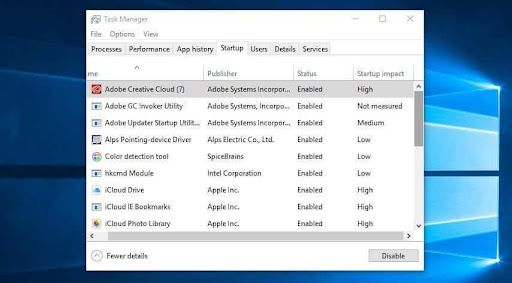
If you are wondering how to make windows 10 faster? Then analyze the items to decide which ones don’t automatically start when the system loads for the first time. Closing the programs with the highest Startup impact will have the best effect on speeding up the startup. However, be careful not to disable any of the vital programs that the system requires to run correctly.
Hint: Any program published by Microsoft should not be disabled. You can learn about items that you aren’t sure about on Google so that you won’t close down any important ones accidentally.
Right-click on the name of the programs and select Disable to disable items that run on startup; this will not disable the program entirely from the system.
3. Update Windows, drivers, and apps
There are multiple benefits of keeping the different parts of your software up-to-date: security, while the others are performance-related. Usually, you will get an alert or notification by Windows for an available update; make sure that you go through with the recommended update and don’t put it off for too long.
If you missed a notification or purposefully ignored it, you can always check for available updates in the settings. Click on Start and go to the Settings, then select Updates & Security and go to Windows Updates.
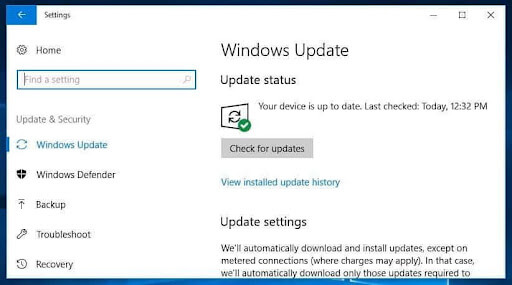
Besides, keeping the OS up-to-date is also crucial to keep apps and drivers current because they can also impact speed and security. If you want to learn more about the latest versions you should be using on your system, simply do a quick online search to learn everything you need.
4. Delete unnecessary files
Most of us find it challenging to be productive while working on a cluttered desk or space; likewise, the performance of your computer can be impacted negatively if the storage space is full of unnecessary files, apps, and programs. The bad thing about the mess in your laptop or PC is that it can be completely hidden, and you wouldn’t be aware of what it’s doing to the performance of your device.
So, how to speed up your computer? The main culprits are the large files, typically the audio, video, and high-resolution images that you might be saving on a daily basis and forgetting about them. You can free up some much-needed storage space by regularly deleting and emptying the recycling bin. We suggest that you do it on a weekly basis if you save many files regularly. Please don’t take too long to declutter your files, or you will likely forget about them or make the mistake of removing something important in a hurry.
Top Tip: if your laptop or PC has an SSD, we recommend decluttering and reorganizing on a regular basis because they tend to slow down gradually and face serious performance issues if it is filled to more than 75 percent capacity. On the other hand, HDDs don’t have speed problems until they are 90 percent full. Therefore, irrespective of which type of storage you have, check to see how full it is.
5. Find programs that eat up resources
This one is for when you find that your laptop or PC has slowed down significantly and all of a sudden, then it might be caused by a particular program. So, how to make your computer faster? The easiest way to get to the bottom of this issue is to go to the Task Manager, figure out which software is consuming a lot of resources, and then figure out what to do about it. Here’s what we suggest:
Go to the Task Manager by right-clicking the taskbar and select Task Manager. Then click on More details to learn additional information about the different programs currently running in the Processes tab, which should open by default.
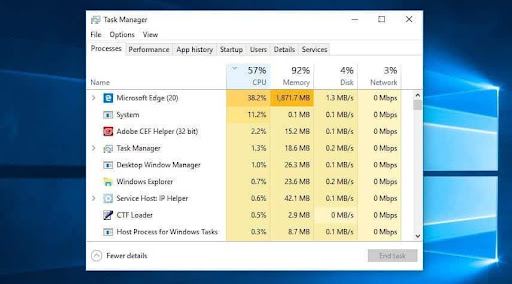
You can learn more by selecting the various headers, which will give you a clear idea about the program using the most resources. To close a program, initially try shutting down the application. If it doesn’t work, open the Task Manager again, right-click on the app’s name from the list, and select End task.
6. Adjust your power options
Many people are unaware that Windows has some preset ‘power plans’ that can be adjusted according to your needs. The Balanced option is the default setting. The power option you select affects the performance and how much energy your computer consumes. You might want to keep energy consumption down if you are running low on battery or concerned about the electricity bill.
If you wish to make your computer faster, select the High-performance option, better for PCs that have slowed down. This plan prioritizes performance over energy consumption.
Alternatively, you can also make customized plans by going to the Control Panel, then clicking on Hardware and Sound, choosing the Power Options, and selecting the Create a power plan. You can name your name and click on Next.
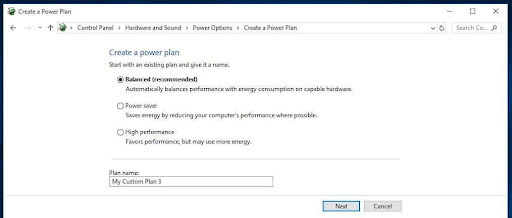
Tweaking the options in Change advanced power settings can help you improve the performance of your system.
7. Uninstall programs you don’t use
Sometimes we are oblivious about the amount of storage some programs occupy, which slow down the PC. Suppose you are concerned that the negative impact on your laptop’s performance is caused by storage-hungry applications that you might not be using or have forgotten about completely. In that case, it’s time to uninstall them.
To uninstall any program from your computer, go to the Control Panel; once there, click on Programs and then select Programs and Features.
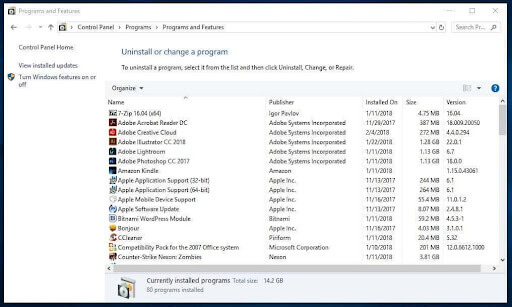
In this window, you will see a list of programs currently on your computer, simply analyze them and find out which ones you can get rid of to free up space.
You can always Google about anything you are uncertain about. There is some helpful software in the market that can assist you in distinguishing between what you need and what you should remove.
8. Turn off unnecessary Windows components
Check if there are any unnecessary Windows components in the Programs and Features screen. To check the Windows components currently running, click the Turn Windows Feature on or off option.
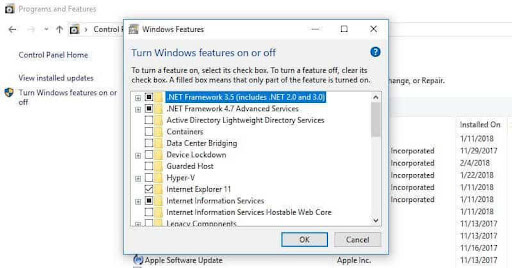
Now check carefully and turn off anything that you don’t need. Ensure that you do not turn off everything at once; you should rather patiently check and confirm the necessity of the component before closing it.
9. Run a complete disk cleanup
You can easily clean up the junk that has accumulated over time with the help of Windows’ inbuilt cleaner. You can easily access the Windows Disk Cleanup Tool by following the steps:
- Open the Windows menu and type Control Panel in the search bar. After opening the Control Panel and select the System and Security option.
- Next, select Administrative Tools and select the Disk Cleanup option from the menu list.
- Now select all files that you want to remove, and click Ok.
- After these steps, click on Clean Up system files and select the system files you want to remove from Windows 10.
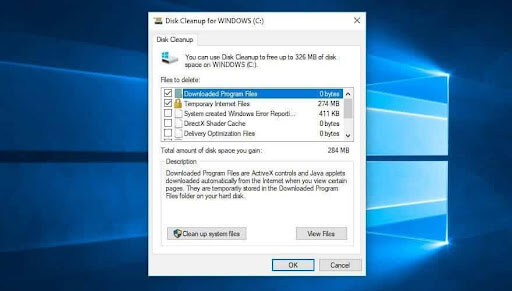
10. Hard Drive Defragmentation
If you are wondering why is my computer so slow? There are chances that your hard drive files become fragmented with time. Your computer can run slow if you have fragmented files. To fix the fragmentation issue, you would have to defragment the hard drive. The defragmentation process might sound like a highly technical process; however, it is simply a process to put fragmented files together to help your computer run more efficiently.
Windows 10, 8, and 7 can run an automatic process for defragmentation on a set schedule. It is better to schedule a few or at least one automatic defragmentation process per week. You can also defragment the files manually at any time if you suspect an issue or if your computer is speeding down.
Also, note that you can only run a defragmentation process on computers with a traditional mechanical Hard Disk Drive (HDD). If you have a Solid State Drive (SSD), then no defragmentation is necessary. If your computer has both HDD and SSD, then run the defragmentation process only on the HDD.
To run a defragmentation process, follow these steps:
- Open My Computer and right-click on WINDOWS (C:) (the default name of a Windows hard drive, yours might be different if you have renamed your hard drive)
- On the right-click menu, select Properties. Now click on Tools, find the Optimize and defragment drive option and click on Optimize.
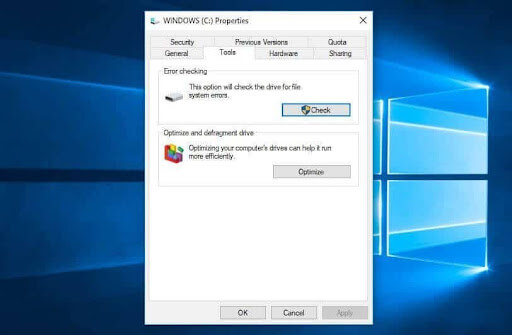
- Once the Optimize Drives screen pops up, select the HDD drive and press the Analyze option to check the hard drive’s fragmented. If it is fragmented more than 5 percent, then it needs optimization. Select the Optimize option to initiate the defragmentation process.
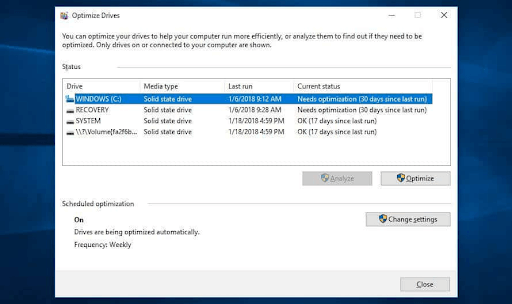
The Analyze option will not be visible if you have an SSD drive. However, the Optimize option is available for SSD drives. Be cautious with selecting the Optimize option for SSD because it will run the TRIM Command and wipe out all the data that is not considered in use.
11. Disable or adjust graphics and animations
Wondering why is my laptop so slow? If your laptop has one of the latest versions of Windows, then it will have an abundance of graphics and animations. These animations and graphics may help make the software and apps look more attractive and add the majority to the usability of the software. However, these apps can cause computer running slow issue.
Luckily, you can adjust the settings to improve the processing speed of your computer. Follow these steps to adjust the graphics and animations of your laptop:
- Open the Control Panel. Find and select the System and Security option. Then click on System and then select Advanced system settings.
- Now open the Performance section and click the Visual Effects tab to open the complete visual effects options and settings list.
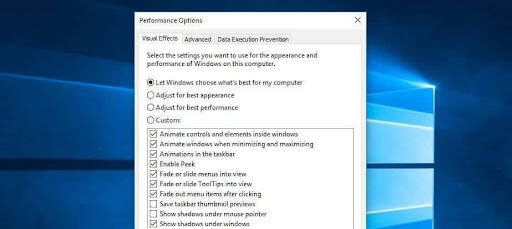
- Now choose Adjust for best performance – to remove all visual effects. You can also remove the visual effects individually; however, the impact on processing performance may not improve noticeably if you only remove a few selected visual effects.
12. Check and remove malware
Apart from other harms that malware or malicious programs can cause, malware can also significantly affect the processing speed. Malware can enter the laptop system via various sources, including software downloads, email links, ads (malvertisements), game/movie/music downloads, and other platforms.
Installing reliable antivirus software can protect your data and help you protect your computer from the malware that causes performance issues.
You don’t necessarily have to spend a significant amount on antivirus software because there are plenty of free options that are both trustable and highly efficient, including avast, Avira, and more.
Reliable antivirus software scans for and removes malicious components that might harm your laptop’s performance. So, you can protect your data and speed your laptop’s performance without any hassle for free.
Also, remember that free antivirus software is not 100% reliable, plus they come with limited security features. For ultimate protection from malware, you should invest in reliable paid antivirus software like McAfee, Norton, Avast premium, etc.
Although all antivirus software run a virus detection scan multiple times a day, however, if you suspect that malware could be slowing down your PC, then you should run a quick scan and immediately remove the malware with the help of any of our top 10 free antivirus software.
13. Disable Windows 10 Cortana
Although Cortana is an excellent digital assistant that makes tasks faster and more convenient, it can slow down your laptop significantly. Cortana is a resource-hungry software, so you might have to give up your helpful Windows 10 assistant if you want a faster laptop.
Cortana can be a challenge to remove, so comment below if you want us to share a quick guide for removing Cortana.
14. Upgrade your hardware
If none of our other fixes work for you, then you should consider upgrading your laptop’s hardware. Following are the two Hardware options you should consider:
- Add additional RAM: Having an older computer means you would most probably have too little RAM to run modern software on your laptop efficiently. You would most probably also not have sufficient RAM to run multiple apps simultaneously. Therefore, the best fix in your case is to install an additional RAM kit and give your laptop a much-needed memory boost.
- Add an SSD: Although adding an additional HDD would cost less, however, for a little more money, you can add an SSD that’ll significantly improve your laptop’s processing speed. SSDs justify their cost in the long run, so what may seem like an expense now will prove to be an investment in the future.
15. Increase Virtual Memory
Windows will momentarily transfer some data from RAM to a paging file on your hard disk. This is done when your device lacks sufficient physical memory to run the software. The system controls the paging file size for the drives automatically by default. However, you can manually increase the amount of space occupied by this paging file in order to speed up the system.
To do so, go to ‘My PC’ and select ‘Properties.’ Then, select ‘Advanced System Settings in a new pop-up window.’ Then, select the ‘Settings’ option in the Performance area. This will open another pop-up window where you must select the ‘Advanced’ tab.
Under the ‘Virtual Memory’ area, click the ‘Change’ button. This will launch a new pop-up window. Uncheck the option next to ‘Automatically manage page file size for all disks’ before selecting ‘Custom size.’ You can now choose how much memory to allocate.
16. Remove Bloatware
Manufacturers pre installed bloatware on many new computers that are similar to older ones. Bloatware on older computers either auto-installs or is left over from an initial program installation; either way, it slows down your laptop. In our experience, removing this unneeded program from your laptop will significantly speed things up.
Old apps that you no longer use also contribute to the problem, and we recommend you uninstall them. Remove them if you aren’t using Dropbox, Microsoft OneDrive, Solitaire, Minecraft, or MS Access. This frees up resources and puts less strain on your laptop’s limited memory and processor.
17. Delete All Web Results in Windows 10 Search
One of the most prominent features of Windows 10, which Microsoft emphasized about the operating system, was its improved search indexing. The function works by establishing an index of all your laptop’s files and folders and information for photographs, videos, and so on. This expedites the process of locating the files you require using the built-in search feature. The search feature in Windows 10 is vastly improved over earlier versions, but it may still be further tuned for aged PCs to boost efficiency.
Because 99.9% of us use a web browser to look for something, the first step is to disable the web results in the Windows 10 search menu. To disable this function, go to your desktop’s search bar and type “gpedit.msc” (without the quotes), which launches the Group Policy Editor. Then select Computer Policy > Computer Configuration > Administrative Templates > Windows Components > Search from the menu.
You should look for policies such as ‘Do not allow web search,’ ‘Dont search the web or display web results in Search,’ and ‘Do not search the web results in Search over metered connections.’ Each one can be edited and customized by double-clicking it. After disabling the features, restart the laptop to apply the changes. You will no longer see web results or suggestions in the system search bar.
18. Enhance Cooling
Have you ever experienced your laptop becoming uncomfortably warm during summer days, occasionally accompanied by sound like a plane taking off the ground? Unfortunately, this indicates that your computer has crossed the maximum safe temperature for operation, which causes its processors to limit the amount of heat they produce by reducing their performance.
A majority of laptops come equipped with built-in cooling systems, which may include fans or heatsinks, to facilitate the delivery of the highest possible speeds before the temperature of the processor rises to an unacceptable level. However, in many instances, this is not adequate to enjoy the maximum potential of your processor.
One of the solutions that can be found on the market is an external cooling pad, which is a highly recommended, must-have product. By placing this device underneath your laptop, you can cool the device as it constantly blows cold air to help you cool down your laptop. This prevents the laptop’s internal parts from overheating and causing the computer to heat up.
FAQs: How to Speed Up Your Laptop
Why is my laptop running slow?
Your computer will often slow down because it is not making effective use of its available resources. Your laptop has a limited amount of memory, processing power, and storage space available; the most important thing you can do to speed up its performance is to optimize all three of these aspects.
If you are curious about the causes behind the gradual slowdown of your laptop, some or all of the following factors likely are to blame:
- It is excessively hot. If there is excessive heat, your computer will automatically adjust its performance to cope. A fast laptop is the one that is cool. See if the temperatures of your central processing unit are getting too high.
- You are using outdated software. You may experience a decrease in performance if you are not regularly updating your Windows or if you cannot locate drivers that have been updated.
- It is working too hard. If you run an excessive number of programs simultaneously, have a disproportionate number of processes operating in the background, or if your disk use is at 100%, your personal computer will not be able to optimize its performance.
- Memory is depleting. Your computer uses RAM to operate the programs that are currently running. If you use all of your RAM, your computer may become sluggish.
- Disk space is getting low on your computer. If your hard disk is full, there will be less space on your personal computer for temporary files. Your computer will not be able to prevent the fragmentation of the hard disk if it does not have sufficient capacity. The removal of unnecessary files from your computer will liberate precious disk space.
- You have malicious software. Many forms of malicious software, like adware and spyware, consume the resources of your personal computer and cause it to run more slowly.
What are some free ways that may speed up my computer?
It is possible for you to utilize a free antivirus program that comes with optimization features; nevertheless, I strongly recommend that you do not do so. Your data is typically stored by a large number of free antivirus programs, including some of the most famous ones, such as Avast and AVG, and then sold to third parties. Instead, you can speed up your computer for free using a free plan of a reputable antivirus program or downloading a free trial.
Can my VPN cause my laptop to run slowly?
A Virtual Private Network (VPN) will not affect your computer’s overall speed, but it can increase the amount of time it takes for webpages to load. This is particularly relevant if you utilize a service that has servers or algorithms that are not optimized to their full potential.
Recently, larger VPN companies have made significant advancements in this particular area, which is a positive development. Therefore, unless you are already accustomed to browsing at incredibly high speeds, it is highly unlikely that you will notice any change.
After trying multiple suggestions from this article, my laptop continues to run slowly. What else can I do?
Even after doing extensive maintenance or installing a new operating system, if your laptop continues to run slowly, it is possible that the hardware is falling behind. To put it another way, freshly released applications require increasingly powerful hardware increasingly powerful hardware, and your laptop is incapable of keeping up with the demand. In this case you would have to upgrade specific components of your computer; nonetheless, it is possible that you will need to consider changing it in the near future.
What are the different parts of my laptop that I can upgrade?
This solely depends on the type of laptop that you have. The majority of them enable you to replace the hard drive and the RAM, but some of the more expensive versions may also permit switching out the CPU. However, in order to even undertake routine cleaning, you will frequently need to remove the complete casing, and in extreme cases, you may even be required to remove the motherboard. If you do not feel confident in your ability to complete this task, we strongly advise that you seek the assistance of a professional.
Will a solid-state drive (SSD) make my computer faster?
It is true that switching from a hard disk drive (HDD) to a solid-state drive (SSD) would make your personal computer substantially faster. Different from a hard disk drive, a solid-state drive (SDD) is made up of a unified electrical circuitry that does not have any moving elements. This results in your data moving across more quickly and with lower wear and tear levels over time.
Does increasing the amount of RAM on my computer speed it up?
This is not always the case. Your personal computer can be running slowly for reasons other than a lack of RAM. Access the task manager and verify if your computer’s amount of Random Access Memory (RAM) is reaching its maximum capacity. If this is the case, then increasing the amount of RAM in your PC would be beneficial. We recommend having a minimum of 8 gigabytes of RAM for basic online browsing.
How often should I deep clean the physical components of my laptop to ensure that it continues to function without any problems?
Your laptop is becoming sluggish and overheated, then get ready to provide it with some tender, loving care; the moment has come!
If you want your laptop to continue functioning without any hiccups, you are advised to clean and maintain its hardware components at least once a year. This includes cleaning the fan and vents. The accumulation of dust and dirt can have a big impact on the performance of your laptop, with the potential to cause it to overheat or shut down unexpectedly. Please believe me when I say that there is nothing more aggravating than missing crucial work time due to a laptop that is overheating.
Do not, however, be concerned! Maintaining a routine cleaning schedule for your laptop might assist in overcoming these powerful enemies of the computer’s components. You may increase the functionality of your laptop while providing it with a shining, fresh appearance by cleaning it to remove dust and debris it holds.
Equip yourself with appropriate cleaning products and give your device the pampering it deserves by giving it a day at the spa. You will be able to work and play without any annoying interruptions and your laptop will be grateful to you for doing so.
Can the performance of my laptop suffer when I have a slow internet connection?
The ability to browse the web, stream content from Netflix, and play games online all require a reliable, fast speed internet connection. A sluggish Internet connection can be detrimental to operational efficiency.
Utilizing a speed test application such as speedtest.net, can help you evaluate the speed of your Internet connection. You should perform the test multiple times while keeping track of your ping time, download and upload speed. The ideal situation would be for you to have a ping time in the single digits and download and upload rates greater than 10 Mbps.
Take note of the large fluctuations in performance that occur between different tests. This is an indication that your Internet connection is functional but it is not reliable.
Bonus tips
It’s not always your operating system that might be slowing down your laptop; other apps and systems also contribute to slow processing speed. Following are a few additional quick tips to help you speed up Windows 10:
Regularly clean your laptop: Some may not even consider this as an option, but believe it or not, dust and grime can contribute to slowing down your computer. Regularly cleaning and maintaining it can noticeably improve the speed and also prevent overheating.
Removes excessive browser extensions: One of the biggest causes of slow browsing experience is having excessive browser extensions. Regularly remove browser extensions that you don’t often use to improve your browsing experience.
Maintain regular data backups on cloud storage: Ensure that your laptop regularly maintains a data backup on reliable cloud storage. Maintaining data backup on cloud storage will not only protect your data but also help you clean storage space in your laptop, resulting in improved processing speed.
Regularly restart your laptop: We might not even consider this option, but rebooting your computer enables updates to take effect and also shut down stuck programs. Ensure that you restart your laptop once or twice a day at least.
Avoid running multiple programs simultaneously: Allowing multiple programs to run in the background. Rather than minimizing a program, close it if you are not planning to use it anytime soon.
Reinstalling your laptop’s operating system: After you have tried all fixes, consider reinstalling your laptop’s operating system.
Conclusion
We hope that our fixes will help you speed up your laptop. To maintain your laptop’s processing speed, ensure that you regularly update apps, clean memory, and consider hardware updates (if necessary).
Invest time in maintaining your laptop, and it will undoubtedly result in faster processing performance. For further help, please write to use and also share your favorite fix in the comments section.
Read Also

